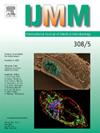生物膜相关性木糖氧化无色杆菌假瓣膜感染性心内膜炎
IF 3.6
3区 医学
Q1 MICROBIOLOGY
引用次数: 0
摘要
革兰氏阴性菌引起的感染性心内膜炎(IE)是一种罕见但越来越被认识到的新发传染病。xylosoxidans无色杆菌是一种革兰氏阴性的非发酵机会性细菌,很少与IE相关,其在体内的生物膜潜力尚不清楚。方法在心脏手术中采集1例木糖氧化单胞菌IE标本。采用荧光原位杂交技术,结合16S rRNA基因PCR和测序技术(FISHseq),对心脏瓣膜组织内的微生物进行可视化观察,以确定与先前血培养分离物的相关性,并建立明确的诊断。受感染的人工瓣膜是在6个月前植入的。植入术后,尽管反复给予适当的抗生素治疗,患者仍在三个多月的时间里出现了木糖氧化杆菌复发性菌血症。结果经食管超声心动图和重复正电子发射断层扫描均未发现感染性心内膜炎。FISHseq在心脏瓣膜样本中检测到A. xylosoxidans,并在体内培养的生物膜中发现了许多微生物,包括fish阳性、代谢活跃的细菌。木糖酸杆菌LB-23-519-25的基因组图谱证实了这种内在多重耐药物种中常见的耐药基因的存在,这与生物膜的形成一起解释了观察到的治疗失败。结论瓣膜培养和影像学未能正确识别该例革兰氏阴性菌IE,但最终根据2023 Duke-ISCVID标准通过FISHseq确定了明确的IE诊断。在未来的患者中,应考虑木氧双歧杆菌的生物膜形成潜力及其对抗菌治疗效果的影响。本文章由计算机程序翻译,如有差异,请以英文原文为准。
Biofilm-associated Achromobacter xylosoxidans prosthetic valve infective endocarditis
Background
Infective endocarditis (IE) caused by Gram-negative bacteria is a rare but increasingly recognized emerging infectious disease. Achromobacter xylosoxidans, a Gram-negative non-fermenting opportunistic bacterium, has rarely been associated with IE and its biofilm potential in vivo is unknown.
Methods
Specimens from a patient with A. xylosoxidans IE were obtained during cardiac surgery. Fluorescence in situ hybridization was used for visualization of microorganisms within heart valve tissues in combination with 16S rRNA gene PCR and sequencing (FISHseq) for correlation with prior blood culture isolates and to establish a definite diagnosis. The infected prosthetic valve had been implanted six months before. Following implantation, the patient developed relapsing bacteremia with A. xylosoxidans over three months, despite repeated adequate antibiotic treatment.
Results
Conventional microbiological analysis of the explanted valve yielded no bacterial growth and prior imaging by repeated positron emission tomography and transesophageal echocardiography did not reveal evidence of infective endocarditis. FISHseq detected A. xylosoxidans in the heart valve samples and demonstrated numerous microorganisms, including FISH-positive, metabolically active bacteria, within in-vivo-grown biofilms. The genomic profile of A. xylosoxidans LB-23–519–25 confirmed the presence of resistance genes commonly found in this intrinsically multidrug-resistant species, which, together with biofilm formation, explains the observed therapeutic failure.
Conclusion
Valve culture and imaging failed to identify this case of Gram-negative bacteria IE correctly, but diagnosis of definite IE was eventually established via FISHseq according to the 2023 Duke-ISCVID Criteria. The biofilm-forming potential of A. xylosoxidans and its implications for the efficacy of antimicrobial therapy should be considered in future patients.
求助全文
通过发布文献求助,成功后即可免费获取论文全文。
去求助
来源期刊
CiteScore
9.70
自引率
0.00%
发文量
18
审稿时长
45 days
期刊介绍:
Pathogen genome sequencing projects have provided a wealth of data that need to be set in context to pathogenicity and the outcome of infections. In addition, the interplay between a pathogen and its host cell has become increasingly important to understand and interfere with diseases caused by microbial pathogens. IJMM meets these needs by focussing on genome and proteome analyses, studies dealing with the molecular mechanisms of pathogenicity and the evolution of pathogenic agents, the interactions between pathogens and host cells ("cellular microbiology"), and molecular epidemiology. To help the reader keeping up with the rapidly evolving new findings in the field of medical microbiology, IJMM publishes original articles, case studies and topical, state-of-the-art mini-reviews in a well balanced fashion. All articles are strictly peer-reviewed. Important topics are reinforced by 2 special issues per year dedicated to a particular theme. Finally, at irregular intervals, current opinions on recent or future developments in medical microbiology are presented in an editorial section.

 求助内容:
求助内容: 应助结果提醒方式:
应助结果提醒方式:


